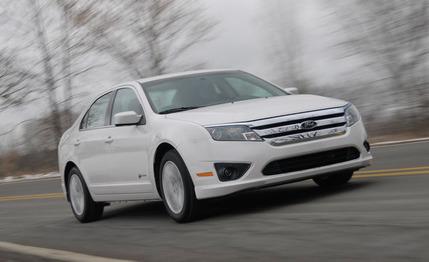
 Short Take Road Test
Short Take Road Test
The first thing you need to know about the 2010 Ford Fusion hybrid is that it’s the best mid-size hybrid sedan on the market. Yes, that’s right: it wipes the floor with the Toyota Camry hybrid.
Like the Camry, it mates a four-cylinder gasoline engine with two battery-driven electric motors and a continuously variable transmission. The Fusion has a 2.5-liter four-cylinder Atkinson-cycle engine that makes 156 hp and 136 lb-ft of torque. Although the Atkinson cycle, where the intake valve is held open longer during the intake stroke, is more efficient than the usual Otto cycle, it doesn’t produce as much power and torque. In a hybrid’s case, electric motors augment the gas engine so that acceleration isn’t compromised. Here, the hybrid system puts out a combined 191 hp.
Ford has worked hard to significantly improve the system in the Fusion over the one in the Escape hybrid, and the company says that the technology is not licensed from Toyota, as Nissan does for the Altima hybrid. The Fusion's trunk-mounted nickel-metal-hydride battery pack is smaller and lighter, for instance, and uses a different chemistry so that it doesn’t need a separate cooling system, simply drawing air in from the cabin to manage temperatures. The pack also produces 20 percent more power. Variable timing on the intake cam allows the vehicle to more seamlessly transition between electric and gas modes, according to Ford, and the Fusion can be driven up to 47 mph on electric power alone, depending on how leadfooted a driver is. Most hybrids can pull off the electric-only trick only as high as 25 mph or so.
Sharp-Looking Exterior, Techy Interior
The all-new Fusion hybrid benefits from many of the changes that were made to the 2010 Fusion range. Externally, the Fusion gets new headlamps, a new front fascia, and a reworked version of the three-bar grille that Ford now uses across its North American offerings. At the back, there’s a new decklid and taillights. The hybrid gets “road and leaf” badging to differentiate it, along with unique eight-spoke, 17-inch wheels. The refresh makes the Fusion sharper looking, particularly since the weird headlamps of the original have been replaced.
Inside, the Fusion also receives a new instrument panel, redesigned seats, and more stylish trim, although the quality of some of the materials isn’t yet on par with those of the class leaders. The hybrid gets what Ford calls SmartGauge with EcoGuide, a unique instrument cluster that is designed to bring out the mileage geek in everyone. Our tech department went gaga over this one, gurgling like toddlers who’ve been allowed outside on their own for the first time. The gauge has four modes—each with touchy-feely names like Engage and Empower—although our more nerdish drivers quickly switched into the expert mode (Enlighten) that shows battery charge level alongside two columns of discharge meters, one for power consumed and the other for the sum of all the accessory loads. The fun is in trying to keep the vehicle in electric mode as long as possible. For non-techies, the Efficiency Leaves feature shows leaves growing on a vine if you’re driving efficiently. It’s actually quite cool.
Our tester came heavily optioned, lifting the price from a reasonable base of $27,995 to $32,555. We had leather seating in place of the standard eco-friendly seat fabric that’s made from recycled post-industrial material, at a cost of $1190 including seat heaters. The excellent touch-screen navigation system added another $1775 to the price, while another $1595 went toward a bundle that included a power moonroof, a rear-view camera, 12-speaker audio system, and a blind-spot warning system.